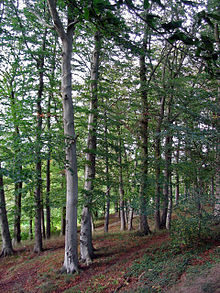| Fagales Temporal range: Late Cretaceous–Recent PreꞒ Ꞓ O S D C P T J K Pg N | |
|---|---|

| |
| Fagus sylvatica | |
| Scientific classification | |
| Kingdom: | Plantae |
| Clade: | Tracheophytes |
| Clade: | Angiosperms |
| Clade: | Eudicots |
| Clade: | Rosids |
| Clade: | Fabids |
| Order: | Fagales Engl. |
| Families | |

| |

| |
| Synonyms | |
| |
The Fagales are an order of flowering plants in the rosid group of dicotyledons, including some of the best-known trees. Well-known members of Fagales include: beeches, chestnuts, oaks, walnut, pecan, hickory, birches, alders, hazels, hornbeams, she-oaks, and southern beeches. The order name is derived from genus Fagus (beeches).
Systematics
Fagales include the following seven families, according to the APG III system of classification:
- Betulaceae – birch family (Alnus, Betula, Carpinus, Corylus, Ostrya, and Ostryopsis)
- Casuarinaceae – she-oak family (Allocasuarina, Casuarina, Ceuthostoma, and Gymnostoma)
- Fagaceae – beech family (Castanea, Castanopsis, Chrysolepis, Fagus, Lithocarpus, Notholithocarpus, Quercus, and Trigonobalanus)
- Juglandaceae – walnut family (Alfaroa, Carya, Cyclocarya, Engelhardia, Juglans, Oreomunnea, Platycarya, Pterocarya, and Rhoiptelea)
- Myricaceae – bayberry family (Canacomyrica, Comptonia, and Myrica)
- Nothofagaceae – southern beech family (Nothofagus)
- Ticodendraceae – ticodendron family (Ticodendron)
Modern molecular phylogenetics suggest the following relationships:
| |||||||||||||||||||||||||||||||||||||||||||
The older Cronquist system only included four families (Betulaceae, Corylaceae, Fagaceae, Ticodendraceae; Corylaceae now being included within Betulaceae); this arrangement is followed by, for example, the World Checklist of selected plant families. The other families were split into three different orders, placed among the Hamamelidae. The Casuarinales comprised the single family Casuarinaceae, the Juglandales comprised the Juglandaceae and Rhoipteleaceae, and the Myricales comprised the remaining forms (plus Balanops). The change is due to studies suggesting the Myricales, so defined, are paraphyletic to the other two groups.
Characteristics
Most Fagales are wind pollinated and are monoecious with unisexual flowers.
Evolutionary history
The oldest member of the order is the flower Soepadmoa cupulata preserved in the late Turonian-Coniacian New Jersey amber, which is a mosaic with characteristics characteristic of both Nothofagus and other Fagales, suggesting that the ancestor of all Fagales was Nothofagus-like.
References
- ^ Angiosperm Phylogeny Group (2009), "An update of the Angiosperm Phylogeny Group classification for the orders and families of flowering plants: APG III", Botanical Journal of the Linnean Society, 161 (2): 105–121, doi:10.1111/j.1095-8339.2009.00996.x, hdl:10654/18083
- "Royal Botanic Gardens, Kew: Databases and Publications". Archived from the original on 3 February 2004. Retrieved 16 October 2018.
- ^ Gandolfo, Maria A.; Nixon, Kevin C.; Crepet, William L.; Grimaldi, David A. (August 2018). "A late Cretaceous fagalean inflorescence preserved in amber from New Jersey". American Journal of Botany. 105 (8): 1424–1435. doi:10.1002/ajb2.1103. PMID 29901855.
External links
| Orders of flowering plants (APG IV) | ||||||||||||||||||||||||||||||||||||||||||||||||||
|---|---|---|---|---|---|---|---|---|---|---|---|---|---|---|---|---|---|---|---|---|---|---|---|---|---|---|---|---|---|---|---|---|---|---|---|---|---|---|---|---|---|---|---|---|---|---|---|---|---|---|
| Angiosperms |
|  | ||||||||||||||||||||||||||||||||||||||||||||||||